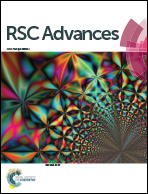Robust superhydrophobic and oleophilic silk fibers for selective removal of oil from water surfaces†
Abstract
The fabrication of efficient sorbents having high selectivity and sorption capacity from natural products has attracted considerable interest due to practical applications in oil spill clean-ups and recovery of spilled oil. Our work presents the preparation of a natural sorbent material with superhydrophobic character, excellent selectivity and high oil sorption capacity using silk fibroin fibers, where the fibers were surface modified with octadecylamine via a simple synthetic approach. The sorbent fibers were found to possess superhydrophobic character with a static water contact angle of 150 ± 3°. The results of oil sorption experiments on oil–water mixtures infer that the modified fibers possess excellent selectivity as well as oil sorption ability, where the oil sorption capacity (OSC) of the material was found to be 46.83 g g−1 for crude oil and 84.14 g g−1 for motor oil. Moreover, the oil sorption capacity of our fiber for motor oil is almost 8 times higher than natural wool, and twice higher than the silkworm cocoon waste. The modified fibers have significantly higher OSC values for crude oil (3.5 times higher) than any wool based sorbents. The suitability of the material over a wide pH range of 3–11 substantiates its advantage in oil sorption even in any corrosive environment. Further, the oil recovery and reusability of the fibers were tested to investigate their applicability for repeatable usage in oil spill clean-up application.


 Please wait while we load your content...
Please wait while we load your content...